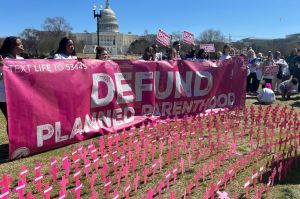Proposed Spending Bill Would Increase Abstinence Sex Education Funding by 50 Percent

The bipartisan federal spending bill being advanced by the GOP-led United States Congress would significantly increase funding for sexual education programs that teach children that the best way to avoid pregnancy and sexually transmitted diseases is by avoiding sexual intercorse until marriage.
The new spending legislation that would keep the federal government funded through the end of September if passed by the the House and Senate would provide a 50 percent increase in funding for the Sexual Risk Avoidance Education (formerly referred to as abstinence-only education) program, which funds projects "to implement sexual risk avoidance education that teaches participants how to voluntarily refrain from non-marital sexual activity."
The bill would allocate $15 million to "exclusively implement education in sexual risk avoidance," as compared to the $10 million in federal funding the program received in fiscal year 2016.
"We are happy to see a growing consensus among members of Congress in seeing the importance of giving youth the information and skills to avoid the risks associated with teen sex," Valerie Huber, president of the SRAE advocacy group Ascend, said in a statement. "We especially appreciate the leadership of Appropriations LHHS House chairman, Tom Cole, and Senate chairman, Roy Blunt. Ascend is grateful that these key congressional leaders are placing a meaningful emphasis on the health of our youth."
While the budget proposal would increase funding the for SRAE program, the Teen Pregnancy Prevention (TPP) program, which uses a sexual risk reduction approach, would not receive a funding increase in the budget deal but would still be funded to the tune of $101 million.
Throughout the years of the Obama administration, SRAE advocates had called for greater parity in federal sexual education spending.
Although the $5 million increase for the SRAE program is noteworthy, it still pales in comparison to the amount of funding SRAE received under the presidencies of George W. Bush and Bill Clinton. The Pacific Standard points out that from 1998-2007, SRAE programs were awarded about $50 million per year in federal funds.
"We are optimistic that the FY 2018 spending bill will continue this positive momentum and every indication suggests that this will be the case," Huber said. "Today's news means that more youth can receive SRA education in 2017. We are encouraged that this news signals even greater gains to be made on this important issue."
According to Ascend, research shows that "waiting for sex resonates with teens, since most teens are not having sex, far fewer than 25 years ago."
A Center for Disease Control study released late last year found that people who abstain from sex are much healthier than their peers who engage in sexual activities.
"The [Center for Disease Control] considers teen sex to be a youth risk behavior, so it makes sense that we give teens the skills to avoid that risk," Ascend said in a statement. "America's sex education policy should reinforce the healthy decisions of the majority, while also providing help to those making unhealthy decisions by giving them the skills to return to a risk-free status. In this way, SRA education, resonates with those who have never had sex, as well as those who are sexually experienced."
Opponents of SRAE have argued that type of education is "ineffectual." A study done by Mathematica Policy Research from 1998-2007 claims that SRAE programs "had no effect on the sexual abstinence of youth" and "that youth in these programs were no more likely to have unprotected sex, a concern that has been raised by some critics of these programs."
However, research done by the Barna Group found that about four out of 10 18- to 19-year-olds felt that their contraceptive-focused sexual education classes made sex seem like an expectation.
The House and Senate are expected to vote on the proposed 1,665-page spending bill endorsed by the White House sometime this week.





























